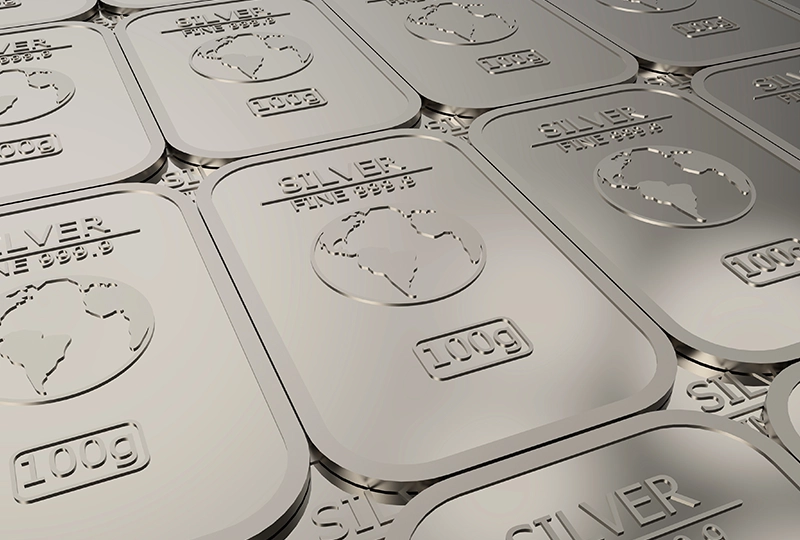What is Bullion?
Bullion refers to precious metals, usually gold or silver, that meet specific high-purity standards and are in the form of bars, ingots, or coins. Bullion is held by investors as a store of value or used by banks and governments for international trade purposes.
The key features of bullion.
High purity.
For gold, it must be at least 99.5% pure gold, and for silver, at least 99.9% pure silver. This ensures its inherent value.
Mass-produced.
Bars and coins are manufactured by mints and refineries in large quantities to meet investing demand. This makes for easy purchase and sale.
Priced near “spot” value.
The bullion price closely correlates to the prevailing spot market prices for gold or silver, with low premiums over the spot.
Bullion organizes large quantities of high-purity precious metals into standardized products that are convenient to store, transport, and trade as assets and investments. Bullion can provide portfolios with protection against inflation, political uncertainty, and volatile markets.
What is Gold Bullion?
Gold bullion refers to pure gold which is officially recognized as being at least 99.5% pure and is in the form of bars, ingots, or coins. Typically, gold bullion is held by central banks and used for trade on commodities exchanges or between large financial institutions. It is considered an investment-grade asset to store value as gold maintains its purchasing power over long periods.

Common forms of Gold Bullion include:
Gold Bars
are produced by refineries or mints in various sizes from 1 gram up to 400 ounces. They may be further classified as cast, hand-poured, or minted bars.
Gold Bullion Coins
These are special commemorative coins made of gold by government mints with a legal tender face value, struck in weights typically ranging from 1/10 oz to 1 oz coins. Popular global gold coins investors desire the American Gold Eagle, Canadian Gold Maple Leaf, and Australian Gold Kangaroo.
Gold Rounds
These are similar to coins but without legal tender status and produced by private mints, usually at lower premiums over gold spot price than official gold coins. Come in one-troy ounce and fractional sizes.
Gold bullion remains a popular investment asset due to its historical store of value. It provides portfolio protection against inflation, market volatility, and geopolitical uncertainty.
What is Silver Bullion?
Silver bullion refers to pure silver officially recognized as at least 99.9% pure precious metal. It is silver held in the form of bars, ingots, or coins primarily as an investment and store of value.

Common forms of Silver Bullion include:
Silver Bars and Ingots
Produced by private or government-operated mints in various sizes from 1 gram to 1,000 ounces. It may come in basic shapes or detailed designs. Popular among individual investors.
Silver Bullion Coins
Special collector coins made of silver by government mints, struck in sizes from one ounce to fractional coins, with a legal tender face value. Top global coins sought by investors include the American Silver Eagle, Australian Silver Kangaroo, Canadian Silver Maple, etc.
Silver Rounds
Privately minted silver discs in one troy ounce or fractional sizes, without legal tender status. Usually carry lower premiums over spot silver price than official coins.
Silver remains appealing as an affordable precious metal investment with greater price volatility than gold. It also has industrial applications affecting its demand. Silver can diversify portfolios and hedge against inflation or economic downturns.
What is Platinum Bullion?
Platinum bullion refers to pure platinum, officially certified as being at least 99.95% pure precious metal. It is held in the form of bars, ingots, or coins, mostly for investment purposes.

Common forms of Platinum Bullion include:
High purity standards
Must be .9995 pure platinum to qualify as bullion. This ensures its inherent and resale value.
Platinum Bars and Ingots
Mass produced by refiners and mints in various sizes from 1 gram up to 100 oz. Allow convenient storage and transport.
Platinum Bullion Coins
Special platinum coins struck by government mints in set weights like 1/10 oz and 1 oz, with a legal tender face value.
Platinum Pricing
Trades at prevailing platinum spot prices plus a small premium from the manufacturer.
With platinum more rare than gold or silver, platinum bullion provides portfolios a way to diversify into this durable precious metal. It hedges against inflation and market volatility over extended periods.
Stay up to date on YouTube.
Want to keep up with our latest precious metal inventory, Deal of the Day, and news? Be sure to follow and subscribe to the Coinhuskers YouTube channel!
Subscribers are also the first to know about any updates showcasing new bullion and coin arrivals in our vault so you can see exactly what’s available for purchase. If you want insider access, click the red “Subscribe” button on our YouTube channel.